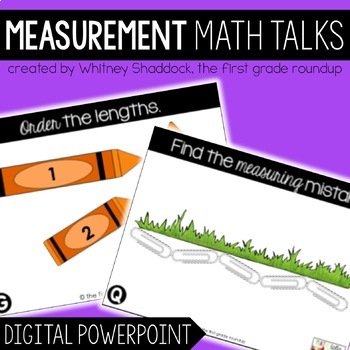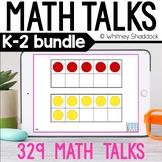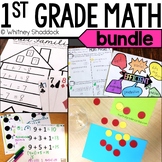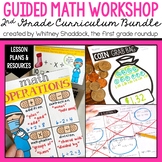Measuring Length Math Talks Printable AND Digital
- Zip
Also included in
- Young learners make sense of their math world and numbers by talking about it! Number Talks give your K-2 kids ways to talk purposefully about numbers, addition, subtraction, fact families, true or false equations, shapes, linear measurement and data graphs. In this large number talks bundle you wPrice $29.00Original Price $38.00Save $9.00
- It's hard to find a 1st grade math curriculum that is rigorous AND engaging! Look no further! This first grade guided math curriculum has 1st grade math lesson plans already written for you plus all the materials needed to implement guided math workshop right away.WHY GUIDED MATH WORKSHOP?Many teachPrice $159.00Original Price $221.00Save $62.00
- Do you feel lost planning second grade math each week? Do you feel like you have some good pieces or parts of your 2nd grade math curriculum, but you can't seem to fit them all in or make them all work together? Guided math workshop is for you! WHY GUIDED MATH WORKSHOP?Many teachers and districtsPrice $149.00Original Price $212.50Save $63.50
Description
First graders make sense of their math world and numbers by talking about it! These printable and digital measuring length math talks give your kids ways to talk purposefully about linear measurement and the measurement standards for K-2.
Visit my blog for ideas on how I used this in my classroom.
INCLUDED IN PRINTABLE & DIGITAL MEASURING LENGTH MATH TALKS are slides with purposefully planned math talks to get K-2 kids talking about length, attributes and rules for measurement. There are multiple math talks for each area...20 total measurement activities. Here are the categories addressed with these measuring length math talks:
• measurable VS non-measureable attributes (2)
• finding appropriate tools to measure length (2)
• ordering length of 3 objects (2)
• ordering height of 3 objects (2)
• non-standard measurement using one or two units to compare (4)
• standard measurement and estimation with rulers (4)
• Find the Mistake (measurement examples addressing the following problems with linear measurement: gaps, overlaps, straightness of units, unit size)
This product is available as a DIGITAL interactive powerpoint or PRINTABLE pdf file. Plus, a main menu for easy navigation on each page! (Note: navigation links are only available in the PowerPoint file.)
RELATED RESOURCES:
Year Long Graphing Printables for K-2
More Math Skills Practice with Math Walls for the entire year!
RELATED VIDEOS:
What Is A Math Talk? (Intro & Routines)
Copyright Whitney Shaddock, 2019, licensed for one classroom use only. Please use the multiple licensing option for more than one classroom use!
Let's Connect:








